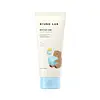What's inside
What's inside
 Key Ingredients
Key Ingredients

 Benefits
Benefits

 Concerns
Concerns

 Ingredients Side-by-side
Ingredients Side-by-side

Water
Skin ConditioningButylene Glycol
Humectant1,2-Hexanediol
Skin ConditioningGlycerin
HumectantPanthenol
Skin ConditioningMethylpropanediol
SolventOctyldodeceth-16
EmulsifyingCarbomer
Emulsion StabilisingTromethamine
BufferingEthylhexylglycerin
Skin ConditioningAvena Sativa Kernel Extract
AbrasivePotentilla Anserina Extract
Skin ConditioningPolyquaternium-51
Skin ConditioningCynara Scolymus Leaf Extract
Skin ConditioningDioscorea Japonica Root Extract
Skin ConditioningLaminaria Japonica Extract
Skin ProtectingAloe Barbadensis Leaf Extract
EmollientUlmus Davidiana Root Extract
Skin ConditioningViola Mandshurica Flower Extract
AntioxidantHydrogenated Lecithin
EmulsifyingBeta-Glucan
Skin ConditioningCamellia Sinensis Leaf Water
MaskingTocopherol
AntioxidantCeramide NP
Skin ConditioningDipropylene Glycol
HumectantCholesterol
EmollientEctoin
Skin ConditioningPalmitic Acid
EmollientStearic Acid
CleansingPropanediol
SolventGlyceryl Stearate
EmollientCeramide As
Skin ConditioningCeramide AP
Skin ConditioningCeramide Ns
Skin ConditioningSucrose Distearate
EmollientCaprylic/Capric Triglyceride
MaskingHydroxypropyl Cyclodextrin
MaskingCeramide EOP
Skin ConditioningWater, Butylene Glycol, 1,2-Hexanediol, Glycerin, Panthenol, Methylpropanediol, Octyldodeceth-16, Carbomer, Tromethamine, Ethylhexylglycerin, Avena Sativa Kernel Extract, Potentilla Anserina Extract, Polyquaternium-51, Cynara Scolymus Leaf Extract, Dioscorea Japonica Root Extract, Laminaria Japonica Extract, Aloe Barbadensis Leaf Extract, Ulmus Davidiana Root Extract, Viola Mandshurica Flower Extract, Hydrogenated Lecithin, Beta-Glucan, Camellia Sinensis Leaf Water, Tocopherol, Ceramide NP, Dipropylene Glycol, Cholesterol, Ectoin, Palmitic Acid, Stearic Acid, Propanediol, Glyceryl Stearate, Ceramide As, Ceramide AP, Ceramide Ns, Sucrose Distearate, Caprylic/Capric Triglyceride, Hydroxypropyl Cyclodextrin, Ceramide EOP
Water
Skin ConditioningCyclopentasiloxane
EmollientGlycerin
HumectantPEG-10 Dimethicone/Vinyl Dimethicone Crosspolymer
StabilisingCyclohexasiloxane
EmollientMagnesium Sulfate
Phenoxyethanol
PreservativeChlorphenesin
AntimicrobialParfum
MaskingDimethiconol
EmollientCamellia Sinensis Leaf Extract
AntimicrobialMorus Alba Bark Extract
Skin ConditioningPanax Ginseng Root Extract
EmollientAloe Barbadensis Leaf Juice
Skin ConditioningOryza Sativa Bran Extract
Skin ConditioningAllantoin
Skin ConditioningPanthenol
Skin ConditioningTocopheryl Acetate
AntioxidantSodium Hyaluronate
HumectantLinalool
PerfumingAscorbyl Tetraisopalmitate
AntioxidantButylene Glycol
HumectantBenzyl Benzoate
AntimicrobialLimonene
PerfumingHydroxycitronellal
PerfumingCitronellol
PerfumingCI 42090
Cosmetic ColorantWater, Cyclopentasiloxane, Glycerin, PEG-10 Dimethicone/Vinyl Dimethicone Crosspolymer, Cyclohexasiloxane, Magnesium Sulfate, Phenoxyethanol, Chlorphenesin, Parfum, Dimethiconol, Camellia Sinensis Leaf Extract, Morus Alba Bark Extract, Panax Ginseng Root Extract, Aloe Barbadensis Leaf Juice, Oryza Sativa Bran Extract, Allantoin, Panthenol, Tocopheryl Acetate, Sodium Hyaluronate, Linalool, Ascorbyl Tetraisopalmitate, Butylene Glycol, Benzyl Benzoate, Limonene, Hydroxycitronellal, Citronellol, CI 42090
 Reviews
Reviews

Ingredients Explained
These ingredients are found in both products.
Ingredients higher up in an ingredient list are typically present in a larger amount.
Butylene Glycol (or BG) is used within cosmetic products for a few different reasons:
Overall, Butylene Glycol is a safe and well-rounded ingredient that works well with other ingredients.
Though this ingredient works well with most skin types, some people with sensitive skin may experience a reaction such as allergic rashes, closed comedones, or itchiness.
Learn more about Butylene GlycolGlycerin is already naturally found in your skin. It helps moisturize and protect your skin.
A study from 2016 found glycerin to be more effective as a humectant than AHAs and hyaluronic acid.
As a humectant, it helps the skin stay hydrated by pulling moisture to your skin. The low molecular weight of glycerin allows it to pull moisture into the deeper layers of your skin.
Hydrated skin improves your skin barrier; Your skin barrier helps protect against irritants and bacteria.
Glycerin has also been found to have antimicrobial and antiviral properties. Due to these properties, glycerin is often used in wound and burn treatments.
In cosmetics, glycerin is usually derived from plants such as soybean or palm. However, it can also be sourced from animals, such as tallow or animal fat.
This ingredient is organic, colorless, odorless, and non-toxic.
Glycerin is the name for this ingredient in American English. British English uses Glycerol/Glycerine.
Learn more about GlycerinPanthenol is a common ingredient that helps hydrate and soothe the skin. It is found naturally in our skin and hair.
There are two forms of panthenol: D and L.
D-panthenol is also known as dexpanthenol. Most cosmetics use dexpanthenol or a mixture of D and L-panthenol.
Panthenol is famous due to its ability to go deeper into the skin's layers. Using this ingredient has numerous pros (and no cons):
Like hyaluronic acid, panthenol is a humectant. Humectants are able to bind and hold large amounts of water to keep skin hydrated.
This ingredient works well for wound healing. It works by increasing tissue in the wound and helps close open wounds.
Once oxidized, panthenol converts to pantothenic acid. Panthothenic acid is found in all living cells.
This ingredient is also referred to as pro-vitamin B5.
Learn more about PanthenolWater. It's the most common cosmetic ingredient of all. You'll usually see it at the top of ingredient lists, meaning that it makes up the largest part of the product.
So why is it so popular? Water most often acts as a solvent - this means that it helps dissolve other ingredients into the formulation.
You'll also recognize water as that liquid we all need to stay alive. If you see this, drink a glass of water. Stay hydrated!
Learn more about Water